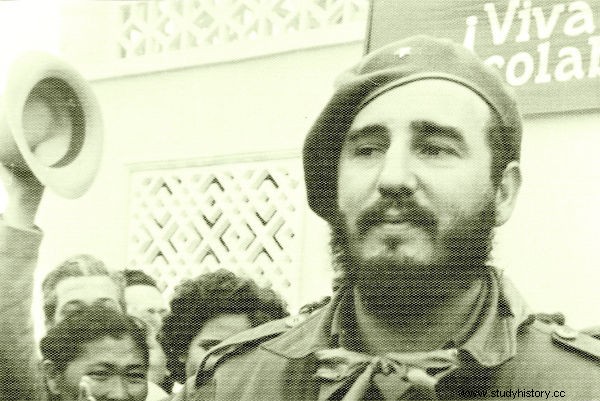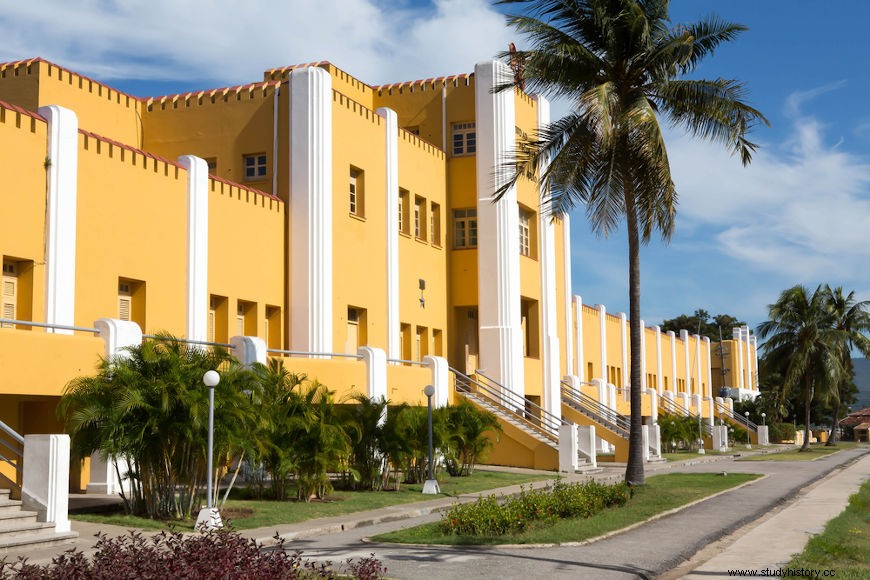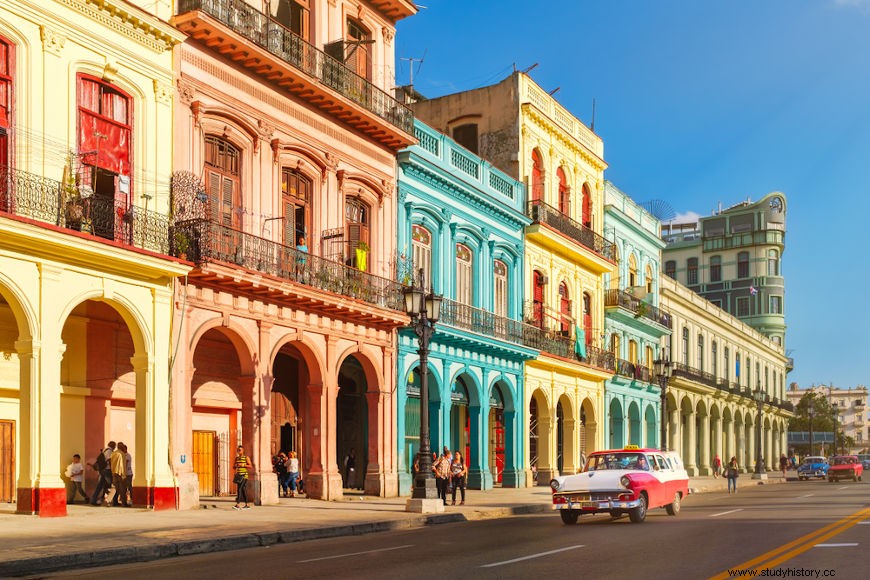Fidel Castro he was the son of a Spanish sugarcane plantation owner who graduated in Law in 1950. His revolutionary trajectory began when he decided to fight for the overthrow of the Fulgencia Batista dictatorship in the 1950s. He was even arrested for the attack to the Moncada Barracks, but was granted amnesty in 1955.
He became the leader of the Cuban Revolution and led a guerrilla that forced the expulsion of Fulgencio Batista from Cuban territory. He was Cuban ruler for 49 years, during which time he had to face one of the most powerful nations in the world:the United States. Health problems forced him to retire from politics in 2008, and his death happened in 2016.
Login also :Gulf War - Why did the Americans attack Iraq in 1991?
Youth

Fidel Alejandro Castro Ruz was born on August 13, 1926, in Birán, where his father owned sugarcane plantation land. His name was made official in a registration carried out in 1941, but before that, Fidel's name had two versions:Fidel Hipólito Ruz González, until 1938, and Fidel Casiano Ruz Gonzaléz, until 1941.
Fidel Castro's father was called Ángel Castro y Argiz , a Spaniard who moved to Cuba during the Spanish-American War and prospered there growing sugar cane. His mother had been a maid at Ángel's house and her name was Lina Ruz González . Fidel and his six brothers were the fruit of this extramarital relationship between Ángel and Lina, which was later made official.
As Fidel's father owned a lot of land in Birán, the financial condition of the family was very good , and Fidel had the opportunity to study in good schools . At the age of six, he was sent to Santiago de Cuba, where he began his studies. In that city, Fidel Castro studied in two schools:La Salle and Dolores.
Then he moved to Havana , the Cuban capital, and there he enrolled in a Jesuit college that was exclusive to a group of wealthy families who could afford it.
Revolutionary trajectory
We can say that the revolutionary Fidel began to develop in the period that he joined the University from Havana to take the Law course . It was in this institution that he had access to revolutionary ideals, carrying out readings that he had not known until then and getting closer to figures who were part of Cuban politics.
At the University of Havana, Fidel was an active student, getting involved in many university activities. There too he engaged with a group called the Legion from Caribbean . This group fought for the overthrow of dictatorial regimes in Central America and the Caribbean. He participated in an action that planned to invade the Dominican Republic to depose Rafael Trujillo, but failed and had to swim for miles to avoid arrest.
In 1948, he still participated in an urban revolt that took place in Bogotá, Colombia, taking shelter in the Cuban embassy to avoid his arrest. After these events, he decided to focus his attention on the course, graduated in law in 1950 . Soon after that, Fidel Castro maintained for a time a law firm .
From his college days, Fidel Castro had a close relationship with the Cuban People's Party , a progressive party with a nationalist character. His relationship with that party made him decide to enter Cuban politics, launching his candidate for the Cuban Congress as a deputy. However, their political plans were thwarted because the election he was to contest in 1952 was canceled after Fulgencio Batista carried out a military coup in Cuba.
Fighting Fulgence

After the military coup, Fidel Castro decided to fight Fulgencio Batista in justice, after all, the coup carried out by Batista was illegal from a constitutional point of view. As he was not successful in this endeavor, he decided to join the fight armada against the Cuban dictator. He formed a rebel group, acquired weapons and prepared to launch an attack.
The location chosen was the Barracks Moncada , which was located in Santiago de Cuba. The objective was to invade the barracks and use it as a base to fight against the Batista government. The attack took place on July 26, 1953, but ended up being a failure, mainly due to the inexperience of Fidel and his followers in carrying out such a military action.
Many of those who participated in the attack were killed, and Fidel and others were arrested . Fidel Castro was tried for leading the attack and made his self-defense. The sentence was issued later that year (1953) and determined that he would be 15 years in prison . However, in 1955 he received amnesty from Cuba and fled the island fearing for his life.
Cuban Revolution
Fidel Castro fled Cuba and settled in Mexico , where his brother Raúl Castro was waiting for him. There he and other Cubans reorganized a group that would return to the Caribbean island to continue the fight against Fulgencio Batista. For this they relied on donations from Cubans who were in the United States and from those who remained on the island.
The group formed in this context became known as the July 26 Revolutionary Movement . In Mexico, Cuban comrades introduced Che Guevara to Fidel. Che Guevara was an Argentine doctor who was based in Guatemala, fleeing there when a military coup overthrew the Guatemalan president in 1954. Che became one of Fidel's great companions in the fight against the Batista government.
Cuban rebels have acquired a yacht named Granma and they decided to return to Cuba in November 1956. There they would be received by comrades who participated in the fight against Fulgencio Batista. However, the yacht was in poor condition, and Fidel and his companions ended up being delayed, with their arrival coming two days later than expected. When they arrived, they were ambushed by the Cuban army .

Most of Fidel's men were killed in this ambush, but Fidel, Raúl and Che Guevara managed to escape in separate groups. They all headed to Sierra Maestra , mountainous region in Cuba. There they were helped by the peasant population and restructured the guerrilla that fought for two years against the Cuban government.
In 1959, the guerrillas led by Fidel managed to leave the Cuban dictator in an uncomfortable position, and on January 1, 1959, he fled to the Dominican Republic. Fidel Castro entered the streets of Havana on January 8 and was hailed as a hero by the population of the capital. To learn more about this important historic event in Latin America, read:Cuban Revolution.
Governor of Cuba
In 1959, Fidel Castro assumed his first position of power in Cuba, being named prime minister in February. He continued in that position until 1976, when he became president country, a position he held until 2008, when health problems forced him to withdraw from public life. Fidel Castro therefore remained in power for 49 years.
He had to face strong opposition from the United States, a country that was not satisfied with the overthrow of Fulgencio Batista. American dissatisfaction increased when Fidel Castro began to take nationalist measures aimed at guaranteeing Cuban national interests. Among them are the law of land reform and the nationalization of companies installed in the country.
In both cases, US companies were harmed, and US reactions to the Cuban government were hostile. The United States disrupted diplomatic relations with Cuba and began to support counterrevolutionary movements to overthrow Fidel Castro from power.
Cuba's isolation caused by US hostility has brought the country closer to the Union Soviet, and that country was the great economic partner of the Cubans until 1991. The alliance between Cuba and the USSR still generated one of the most tense moments in the history of the Cold War:the Cuba Missile Crisis .
Over the years, Fidel Castro has been praised and criticized by many. There are those who highlight the achievements of his government, such as the development of a quality education and health system, while others point out that Fidel Castro implanted a socialist dictatorship that silenced and oppressed the Cuban people.
Login also :How and when did the Berlin Wall come down?
Death
The health problems of the former Cuban leader accumulated from the 21st century onwards, and he was unable to remain in politics, abandoning his duties in 2008. Fidel Castro passed away on November 25, 2016, and his remains were cremated, as requested by Fidel himself. Fidel Castro is considered today one of the great heroes of Cuban history.
Image credits
[1] emkaplin and Shutterstock
[2] northallertonman and Shutterstock
[3] Kamira and Shutterstock
